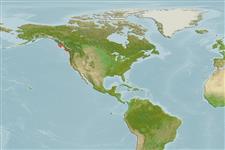Environment: milieu / climate zone / depth range / distribution range
Ekologi
marina bottenlevande; djupintervall 0 - 50 m (Ref. 56557). Temperate; 55°N - 36°N, 129°E - 122°W
Eastern Pacific: southern British Columbia to central California, USA. Authors giving range up to northwestern Pacific classify Pholis nea Peden & Hughes, 1984 as a synonym of Pholis ornata.
Size / Vikt / Age
Maturity: Lm ? range ? - ? cm
Max length : 30.0 cm TL hane/ej könsbestämd; (Ref. 2850)
Short description
Bestämningsnycklar | Morfologi | Morfometri
Taggstrålar i ryggfenan (totalt) : 74 - 79; Mjukstrålar i ryggfenan (totalt) : 0; Taggstrålar i analfenan: 2; Mjukstrålar i analfenan: 35 - 38. Caudal rounded. Pelvic fins minute.
Facultative air-breathing in the genus (Ref. 126274); Found in inshore areas, on mud bottoms among eelgrass and seaweed (Ref. 2850). Feeds on small mollusks and crustaceans (Ref. 2850). Both male and female guard egg mass (Ref. 2850).
Life cycle and mating behavior
Maturities | Reproduktion | Spawnings | Egg(s) | Fecundities | Larver
Oviparous (Ref. 101786). Adhesive eggs attached to a nest substrate are brooded by both parents (Ref. 101786).
Eschmeyer, W.N., E.S. Herald and H. Hammann, 1983. A field guide to Pacific coast fishes of North America. Boston (MA, USA): Houghton Mifflin Company. xii+336 p. (Ref. 2850)
IUCN Red List Status (Ref. 130435)
Threat to humans
Harmless
Human uses
Verktyg
Special reports
Download XML
Internet-källor
Estimates based on models
Preferred temperature (Ref.
123201): 8.9 - 12.5, mean 10.4 °C (based on 42 cells).
Phylogenetic diversity index (Ref.
82804): PD
50 = 0.5005 [Uniqueness, from 0.5 = low to 2.0 = high].
Bayesian length-weight: a=0.00162 (0.00068 - 0.00388), b=3.19 (2.99 - 3.39), in cm total length, based on LWR estimates for this (Sub)family-body shape (Ref.
93245).
Trofisk nivå (Ref.
69278): 3.6 ±0.50 se; based on food items.
Resiliens (Ref.
120179): Mellan, lägsta populationsfördubblingstid 1,4-4,4 år (Preliminary K or Fecundity.).
Fishing Vulnerability (Ref.
59153): Low vulnerability (20 of 100).
